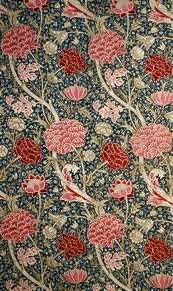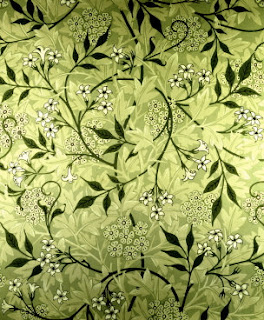In 1852 he entered Exeter College at Oxford where he met fellow student and aspiring artist Edward Burne-Jones with whom he became life long friends.They shared an interest in theology, ecclesiastical history, medieval poetry, visiting English churches and continental cathedrals. They were both influenced by the pre-Raphaelite movement, the poetry of Alfred, Lord Tennyson, and the essays of John Ruskin who rejected the industrial manufacture of decorative arts and architecture in favor of a return to hand-crafted affordable art where artisans were elevated to fine artists. In 1856 Morris began working for one of England's leading Gothic revival architects headquartered in Oxford. Also that year Morris became editor and publisher of a new Oxford and Cambridge Magazine where he met another life long friend and pre-Raphaelite painter, Dante Gabriel Rossetti, a magazine contributer. Rossetti eventually persuaded Morris that he was better suited for painting rather than architecture; so Morris threw himself into his painting.
Rossetti met and recruited Jane Burden, a striking beauty, to become a model for him. Soon Morris met Jane and was smitten. They wed in 1859. Their happiness did not last the first 10 years of their marriage but divorce was out of the question so they remained married until Morris's death even though Jane had a long affair with Rossetti, often spending long stays with Rossetti at Kelmscott Manor, William Morris's beloved country house while Morris was away on business.
La Belle Iseult, Jane Burden as model.
The only surviving Morris easel painting.
In 1861, the decorative arts firm of Morris, Marshall, Faulkner & Co. was established with Morris, Rossetti, Burne-Jones, Ford Maddox Brown, Philip Webb, Charles Faulkner and Peter Marshall as partners. The firm would undertake carving, stained glass, metal work, paper hangings, chintzes or printed fabrics and carpets much of it for the decoration of churches. Later the firm expanded to include murals, furniture, glass wares, cloth and paper wall hangings, embroideries, jewelry, silk damasks and tapestries. By 1866 the firm was making a profit. In 1874 Morris bought out his shareholders in order to take sole control of the firm which he held as principle owner and design director. The firm's designs are still sold today.
William Morris was a prolific writer of poetry, fiction, essays, and translations of ancient and medieval texts. He continued to write until his death.
In the 1870s Morris started to take an active interest in politics as a member of the National Liberal League. In the 1880s he advanced into socialist politics founding the Socialist League in 1884 but by the end of that decade he had broken away from that organization over their goals and methods.
Morris was deeply devoted to preservation both in architecture and ancient buildings; but also was interested in preservation in the natural world with great disdain for polution and industrialism and their ravages to nature.
In 1881 Morris expanded to include tapestry in his business where he discovered another means of expressing his love of medievalism that inspired all of his work. Next he developed an interest in typography and the arts of illumination and calligraphy. He designed typefaces based on 15th century models. Soon he added a private printing press and established the Kelmscott Press. Only the best selection of papers, inks, decoration and type made Kelmscott the most famous of private presses of the Arts and Crafts movement. It operated until 1898 and produced over 18,000 copies of 53 different works. Some Kelmscott editions are counted among the most beautiful books ever produced
By 1883 furnishing textiles were an important offering of his firm for which Morris was the chief designer. For this he had to learn the theory and practice of weaving, dyeing and textile printing. He spent much of his time at the Staffordshire dye works learning to master the process and experimenting in reviving the old methods of indigo dyeing and the use of other vegetable dyes which had been driven almost out of use by then. He highly valued rich color, perfect gradation and depth of tone along with crisp, abundant detail as was found in medieval art. Morris taught himself embroidery, working on a frame he had custom built based on an old example. Once he had mastered the art he trained his wife, her sister and others to execute his designs to his specifications. The firm offered designs for embroidery and finished work. Morris became active in the movement toward originality and mastery of technique in embroidery and became one of the first designers with the Royal School of Art Needlework. Additionally Morris revived the art of carpet weaving and the production of woven and printed fabric of the highest quality.
Morris Tiles
Morris Chairs
Many of the Morris's designs utilize flowing meandering lines, the idea of which stems from the meandering of the River Thames and all of its tributaries. In Morris's work these lines become the stems of plants, flowers and folliage that wander through his repetitive designs.
Much of the information for this post came from Wikipedia




















































Maureen, Thanks for this wonderful profile of Morris! I love his work so much, but I didn't know a lot of this about him. His passion for the natural world and his fabric designs are so inspiring...
ReplyDeleteThanks for sharing this history, Maureen. He was amazingly prolific and dedicated to beauty.
ReplyDelete